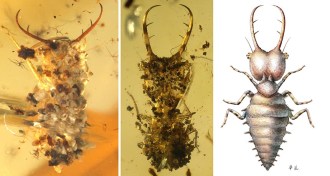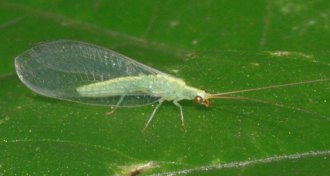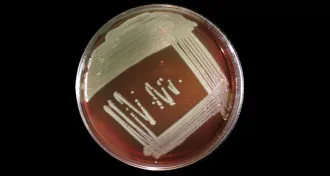Life
Sign up for our newsletter
We summarize the week's scientific breakthroughs every Thursday.
-
 Animals
AnimalsReptile scales share evolutionary origin with hair, feathers
Hair, scales and feathers arose from same ancestral appendage.
-
 Animals
AnimalsInsect debris fashion goes back to the Cretaceous
Ancient insects covered themselves in dirt and vegetation just as modern ones do, fossils preserved in amber suggest.
-
 Animals
AnimalsBacteria make male lacewings disappear
Scientists have tracked down why some green lacewings in Japan produce only female offspring: Bacteria kill off all the males early in life.
-
 Life
LifeScientists find clue to why mitochondrial DNA comes only from mom
Scientists have identified a protein that chops up the mitochondrial DNA in a dad’s sperm after it fertilizes an egg. The finding helps explain why mitochondrial DNA is usually passed on only by mothers.
-
 Life
LifeNew species of bacteria found to cause Lyme disease
Camping? Don’t forget the bug spray. Lyme disease covers new ground.
By Laura Beil -
 Life
LifeFido and Fluffy could unleash drug-resistant microbes
After discovering resistant microbes in pets, scientists worry about the role of companion animals in the spread of resistant urinary infections.
By Laura Beil -
 Animals
AnimalsBaby birds’ brains selectively respond to dads’ songs
The neurons of young male birds are more active when listening to songs sung by dad than by strangers, a new study finds.
-
 Neuroscience
NeuroscienceNewborn brain has to learn how to feed itself
Nerve cells in newborn mice can’t yet feed themselves.
-
 Health & Medicine
Health & MedicineIn malaria battle, indoor bug spraying has unintended consequence
Years of spraying indoors may inadvertently have push malaria-spreading mosquitoes to venture outdoors for a bite.
By Susan Milius -
 Life
LifeBenign-turned-deadly bacterium baffles scientists
Outbreak of Elizabethkingia continues to grow as disease investigators struggle to find source.
By Laura Beil -
 Life
LifeFor cleanest hands, squirt and count to 30
Rubbing hands for 30 seconds is the most effective way to use hand sanitizer, a study of health care workers finds.
By Laura Beil -
 Life
LifeFor tooth decay microbes, many routes lead to kids’ mouths
Mothers aren’t their children’s only source of bacteria that cause dental cavities, new research shows.
By Laura Beil